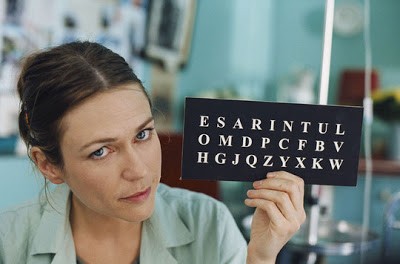Julian Schnabel's THE DIVING BELL AND THE BUTTERFLY
THE DIVING BELL AND THE BUTTERFLY
Written by Ronald Harwood
Directed by Julian Schnabel
Jean-Dominique Bauby: Mon premier mot est je. Je commence par moi.
People often find themselves feeling trapped. They feel trapped at work or trapped in a bad relationship. When we find ourselves in these sorts of situations, we are sometimes fortunate enough to have choices. We can change our surroundings; we can look to new possibilities and put the scenarios that are suffocating us behind us. And if we cant make that change happen immediately, we can find ways to escape for a while. We can go for walks; we can talk to friends; we can go to the movies. Now, thanks to director, Julian Schnabel, we can feel just as trapped at the movies as we already may feel in our regular waking lives. THE DIVING BELL AND THE BUTTERFLY is a French film about one mans true account of what it feels like to experience the medical condition called locked-in syndrome. Someone in this condition can see and think, even remember everything but his body is paralyzed from top to bottom and he cannot move his mouth to speak. As depressing as this all sounds, it is nowhere near as intense as how it feels to see the film from the perspective of the patient, which is exactly where Schnabel places his viewer. Whatever you were escaping wont seem so important after having experienced this cinematic paralysis.
The film is even more devastating because this horror is a true story. Former Elle magazine editor, Jean-Dominique Bauby (played in the film by Mathieu Almarich) suffered a stroke that left him in a coma in 1995. The film tells his story from the moment he awakes from that coma twenty days later. He must battle his way through his confusion to deal with the crushing news that the life he knew is now over. This is a man who worked in fashion. His life was glitz, glamour, always moving and now he is sitting in a cramped hospital room and unable to get out of bed or even sit up. While Bauby wakes up to hell, we wake up to cinematic heaven. Award-winning cinematographer, Janusz Kaminski, developed a style of shooting that shows the viewer what Bauby is seeing. Doctors and orderlies are constantly in his face; images are blurred or skewed depending on how alert Bauby is; and when he closes his eyes, we see nothing but the back of his eyelid. We get out of that claustrophobic space the same way Bauby does by following his imagination, which takes him back to many memories or to all-together new places for experiences hes never had. The dreamy technique is humbling, inspiring and, rather ironically, cinematically alive. Kaminski has taken a paralyzed perspective and made it dance.
Ronald Harwoods script lights a fire of frustration in the viewer while it exposes the stupidity of humanity. While no one around him can hear his thoughts, we are privy to all of them being trapped in the mind where they are formed. The manner in which the senior doctors speak to him and the liberties they take knowing he cannot speak back or push their fingers away while they poke at him exposes the inequities of the medical profession. Hope is casually dropped into the conversation whenever there is nothing more to say. Even in this so obviously dire situation, people cannot directly address pain and suffering. Harwood is also careful not to inundate us with imagery of Baubys former existence. The memories we do see alert us to significant relationships and moments but make no linear trajectory of everything that led up to this. Nor are we subjected to clichés of everything exciting that Bauby will never know again. Instead, we are just shown glimpses of the man we are meant to identify with. This story would be tragic no matter what the background and Harwoods sparse humanization allows us to see that clearly. More importantly, the dialogue in Baubys head and the little that manages to get to those around him allows us to see who he is right now. After all, he is still alive.
As harrowing as this all sounds, THE DIVING BELL AND THE BUTTERFLY is still uplifting. Bauby manages to maintain some of the relationships he had prior to his attack and their new context is a reminder that something deeper than mindless chatter holds them together. And for every bumbling doctor that doesnt know what to do with him, there are just as many others determined to help him, even some that develop all new relationships with him. While his whirlwind life may seem to have come to a deadening halt, he learns a lesson that we all need to remind ourselves of regularly. There is no sense in sitting around feeling sorry for ourselves while we are still alive and capable of progress. If you need an example to see that, you should know that by blinking his way through the alphabet one letter at a time, Bauby wrote the book on which this film is based.
www.blacksheepreviews.com
I have no idea what I'm doing but incompetence has never prevented me from plunging in with enthusiasm.
- Woody Allen




 Reply With Quote
Reply With Quote

Bookmarks